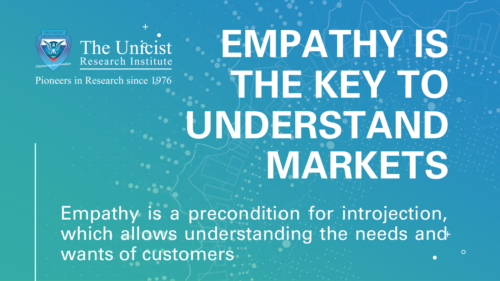The Unicist Approach to Develop Empathy
To understand the real world to influence it in business, it is necessary to be able to introject customers with their needs and wants. The unicist approach defines that empathy is a precondition for introjection, as it involves a deep understanding and connection with the environment or context in which one is operating. Introjection, in turn, is necessary for learning and adapting to one’s environment, as it involves internalizing the norms and values of that environment in a way that allows for effective action and decision-making.
By developing a strong sense of empathy and the ability to introject, individuals can better understand the needs, expectations, and dynamics of the environments in which they operate, and can develop more effective strategies for adapting and thriving in those environments. This can be particularly important in complex or rapidly changing environments, where the ability to learn, adapt, and act quickly can be critical to success.
About introjection
It is true that introjection involves internalizing external experiences or information and integrating them into one’s own psychological makeup. In this sense, it can be seen as a way of making the external world a part of one’s internal world.
When we introject external experiences or information, we make them a part of our own psychological framework, which can help us to better understand and navigate the world around us. By internalizing external experiences, we can create a more holistic approach to our own behavior and to the behavior of others.
Empathy can play a role in this process by helping us to connect with and understand the experiences and perspectives of others, which can then be integrated into our own psychological framework through the process of introjection.
So in this sense, empathy and introjection are closely related, and can work together to help us create a more comprehensive and holistic understanding of the world around us.
Empathy as a condition for introjection
When we empathize with an aspect of the real world, we can use that understanding to help us adapt and adjust to the environment in a way that is both responsive to external influences and consistent with our own internal psychological makeup.
Through the process of introjection, we can internalize external experiences or information and integrate them into our own psychological framework, which can then help us to navigate the world around us in a more adaptive and effective way. By actively adapting to the environment in this way, we can also influence it in turn, creating a feedback loop in which our internal psychological framework and external environment continually shape and influence one another.
So in this sense, empathy and introjection can help us to create a more dynamic and adaptive relationship with the world around us, allowing us to both respond to external influences and exert our own influence on the environment in a way that is responsive to our own internal psychological makeup.
The management of frustrations
Empathy requires a willingness to acknowledge and accept differences, even if they challenge our own beliefs or perspectives. This can be a difficult and sometimes uncomfortable process, as it can require us to confront our own biases and assumptions.
However, by taking the time to actively listen, observe, and reflect on the experiences and perspectives of others, we can begin to expand our own understanding and develop a greater sense of empathy. This process may involve encountering frustration, as we are forced to confront our own limitations and biases. However, by persevering through these challenges and remaining open to new experiences and perspectives, we can deepen our capacity for empathy and become more attuned to the needs and experiences of those around us.
On the other hand, as you mentioned, if we are unable or unwilling to accept differences, we may resort to projecting our own beliefs onto the world around us, which can limit our ability to empathize and connect with others in a meaningful way. By recognizing the importance of empathy and actively working to develop this skill, we can become more effective communicators, collaborators, and problem-solvers, both in our personal and professional lives.
Conclusion
Empathy requires us to move beyond a detached observer role and actively engage with the world around us. Instead of simply observing or analyzing from a distance, empathy involves a more active and immersive approach, in which we seek to understand and connect with the experiences and perspectives of others.
This process of active engagement can be an important part of introjection, as it allows us to internalize and integrate new perspectives and ideas into our own worldview. By actively engaging with the environment and seeking to understand its dynamics and complexities, we can develop a more nuanced and adaptive understanding of the world around us, which can help us to more effectively navigate and thrive in our personal and professional lives.
Overall, empathy and introjection are closely linked, as both involve a deep engagement with the world around us and a willingness to learn, adapt, and grow in response to new experiences and perspectives. By developing these skills, we can become more effective communicators, collaborators, and problem-solvers, and can better navigate the challenges and opportunities that arise in our lives.
Peter Belohlavek










